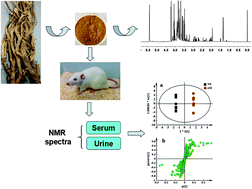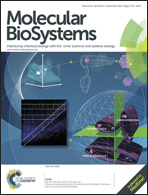1H NMR based metabolomic study of the antifatigue effect of Astragali Radix†
Abstract
Astragali Radix (Huangqi), a well-known traditional Chinese medicinal plant, has been used for centuries as a reinforcing vital energy herb in China. In this study, the antifatigue effect of Astragali Radix was investigated by an 1H NMR based metabolomic approach coupled with multivariate statistical analysis. The results indicated that oral administration of Astragali Radix at a dose of 3 g kg−1 body weight could significantly prolong the exhaustive swimming time of rats, and alter the serum and urine metabolome. The rats treated by Astragali Radix extracts showed higher levels of glucose, creatine, glycine, citrate, guanidinoacetate, allantoin, dimethylglycine, dimethylamine (DMA), creatinine, betaine and malate and lower levels of lactate, choline species, O-acetylated glycoproteins (OAG), glycerol, β-OH-butyrate, α-ketoglutarate, trimethylamine (TMA) and hippurate. And these metabolic changes indicated that Astragali Radix facilitated recovery from fatigue by regulating the glycometabolism, lipid metabolism and energy metabolism. Chemical analysis showed that various components were present in the Astragali Radix extracts, and the bioactive compounds responsible for the antifatigue activity should be further investigated.


 Please wait while we load your content...
Please wait while we load your content...